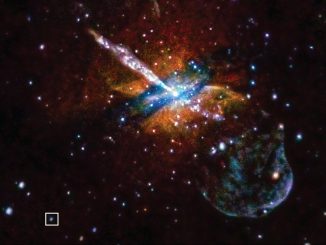
After years of preparation, observsation and data analysis, an international team of astronomers has accomplished a feat once thought impossible by definition: capturing a direct image of a supermassive black hole, or rather the event horizon that marks the boundary between normal space and the unknowable interior.
During simultaneous news conferences around the world on 10 April, the Event Horizon Telescope team unveiled a mesmerizing photo showing the dark hiding place of the 6.5-billion-solar-mass black hole lurking at the core of the giant elliptical galaxy M-87 some 65 million light years away.
“We are delighted to be able to report to you today that we have seen what we thought was unseeable,” Sheperd Doeleman, a radio astronomer at the Harvard Smithsonian Center for Astrophysics and director of the Event Horizon Telescope project, said during a briefing in Washington DC. “We have seen, and taken a picture of, a black hole. This is a remarkable achievement.”
The image unveiled by Doeleman shows a doughnut-like structure or orange light surrounding a black central core — the event horizon of M-87’s supermassive black hole. The encircling ring of light is made up of photons emitted from accelerated particles of gas and dust being pulled toward and around the event horizon at near light speed. The historic image closely matches the predictions of Einstein’s theory of general relativity.
“We now have visual evidence for a black hole,” Doeleman said. “We now know that a black hole that weighs 6.5 billion times what our sun does exists in the center of M-87. This is the strongest evidence we have to date for the existence of black holes. It is also consistent … with Einstein’s predictions.”
Said Daniel Marrone, an astronomer at the University of Arizona’s Steward Observatory: “Today, general relativity has passed another crucial test. … The object at the heart of M-87 is a black hole like those described by general relativity.”
The globe-spanning network of radio dishes, atomic clocks and computers making up the Event Horizon Telescope also is expected to image Sagittarius A*, or Sgr A* for short, the supermassive black hole at the heart of the Milky Way.
Unlike the beast powering M-87, Sgr A* is a relatively modest 4.3-million-solar-mass black hole filling a volume smaller than Earth’s solar system. It is located 26,000 light years away in the core of the Milky Way, generating enormous gravitational effects that can be seen in the motions of nearby stars.
Those motions at the core of the galaxy have been studied for years, providing the mass of the hole along with other insights, but no one has actually viewed the black hole itself.
“Sgr A* is also a very interesting target,” Doeleman said. “We should be able to resolve it. … We’re not promising anything, but we hope to get that soon.”



